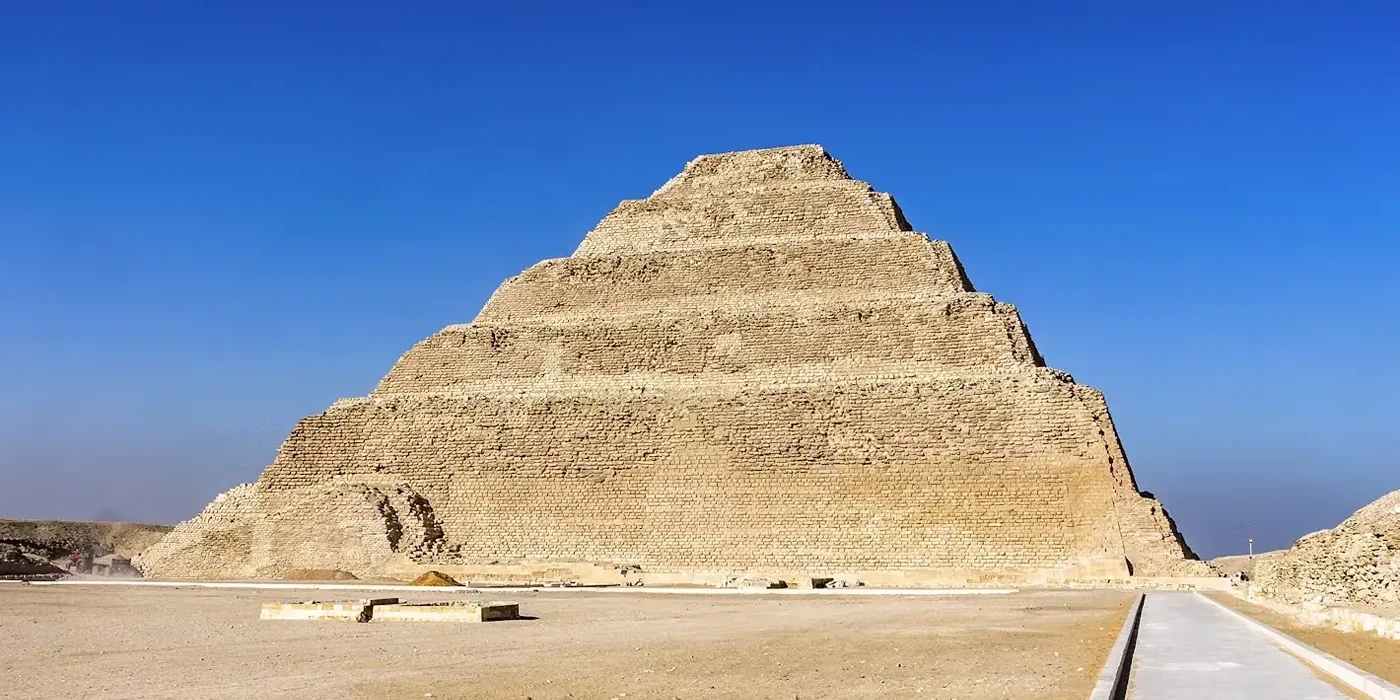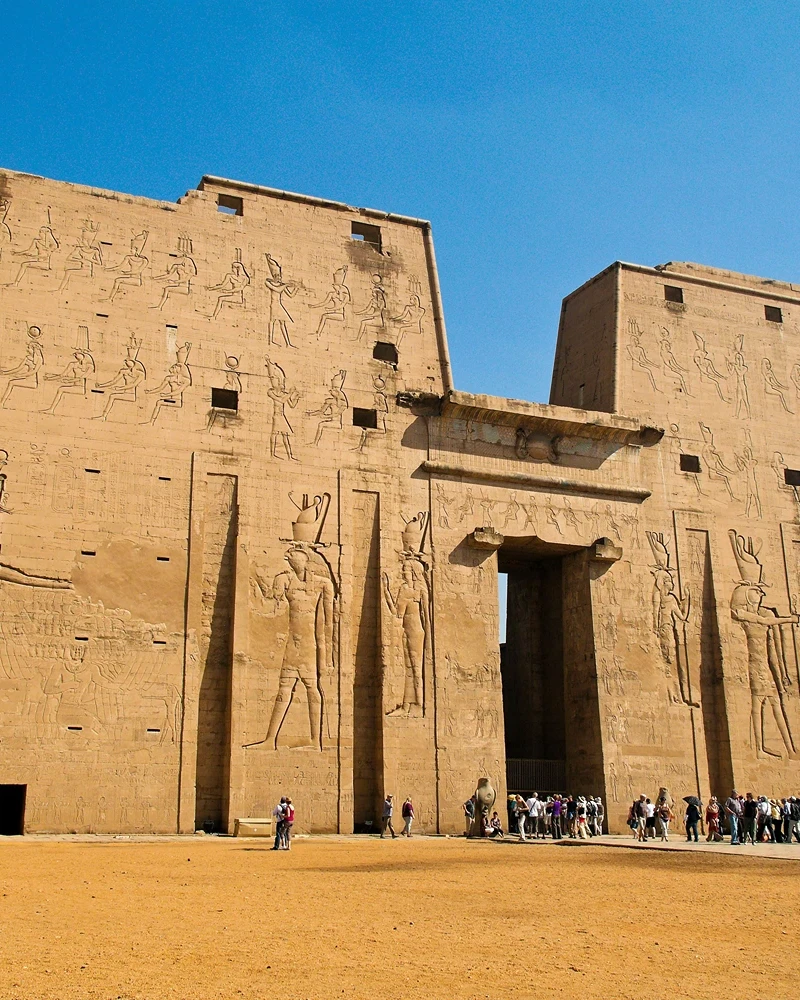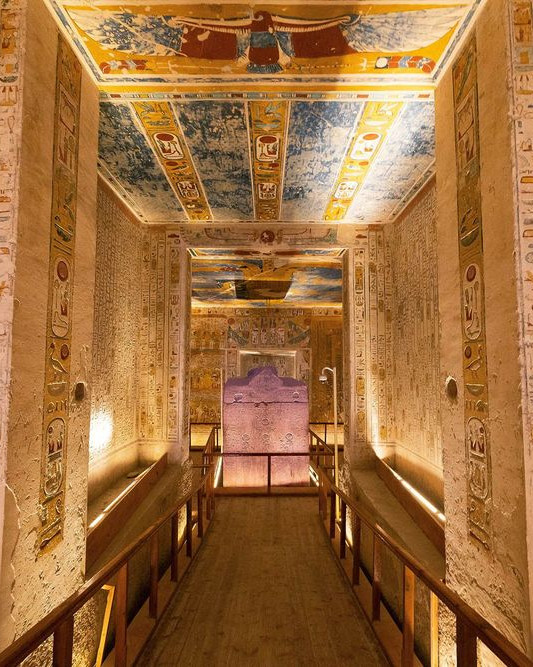Was the Step Pyramid of Djoser the true genesis of Egypt’s monumental architecture? Constructed during Pharaoh Djoser’s reign and masterminded by the ingenious Imhotep, this ancient wonder revolutionized pyramid construction. Initially a simple mastaba, it evolved into a six-tier marvel that stands as a beacon of innovation and historical significance. Discover how the Step Pyramid of Djoser set the foundation for an era of awe-inspiring structures and why its contributions to architectural advancements are still revered today. Dive with us into its historical development to understand its enduring legacy.
Historical Development of the Step Pyramid of Djoser
The Step Pyramid of Djoser, constructed during the reign of Pharaoh Djoser (circa 2691-2625 BC) in Ancient Egypt’s Third Dynasty, marked a significant advancement in architectural techniques. Initially intended as a simple mastaba tomb, the structure underwent several expansions, ultimately evolving into a six-tiered pyramid. This transformation resulted in a monumental structure standing 60 meters high with a rectangular base measuring 121 by 109 meters. This expansion from a mastaba to a stepped pyramid was unprecedented and laid the groundwork for future pyramid constructions.
The mastermind behind this architectural marvel was Imhotep, an architect, physician, and high priest. Imhotep’s innovative design strategies were pivotal in transitioning from traditional mud-brick mastabas to large-scale stone construction. His approach included stacking multiple mastabas on top of each other, creating the pyramid’s stepped appearance. Imhotep’s contributions were so influential that he was later deified and remembered as one of history’s great polymaths.
The Step Pyramid’s construction marked a turning point in ancient Egyptian architecture and had a lasting influence on subsequent pyramid designs. It symbolized the beginning of grand-scale monumental building in stone, reflecting the political and religious ambitions of the time. The pyramid served as both a tomb and a statement of divine kingship, reinforcing the Pharaoh’s status and legacy. Its innovative design and construction techniques set a precedent that shaped the architectural landscape of ancient Egypt.
Significant dates/events in the pyramid’s construction:
- Circa 2691 BC: Pharaoh Djoser initiates the construction of his tomb.
- Initial Phase: The structure begins as a simple mastaba.
- Expansion Phase: Imhotep designs the stepped structure, transforming it into a six-tiered pyramid.
- Completion: The pyramid reaches its final height of 60 meters.
- Subsequent Influence: The design influences the construction of later pyramids in Egypt.
Architectural Innovations of the Step Pyramid
The Step Pyramid of Djoser stands as the earliest large-scale stone structure in Egypt, marking a revolutionary shift in ancient architectural practices. One of the most notable features of the pyramid is its solid core, built with sloping courses of stone blocks. This technique ensured stability and durability, allowing the structure to withstand the test of time. The pyramid’s design was a significant departure from the traditional mud-brick mastabas, introducing a new era of monumental stone construction.
A staggering 271,000 cubic meters of stone were used in the construction of the pyramid, which is equivalent to the load of 30,000 heavy trucks. The stone blocks were likely quarried from a nearby ditch that is 28 meters deep and 2 kilometers long. This quarry not only provided the necessary materials but also demonstrated the logistical prowess required to source and transport such a massive volume of stone. The choice of stone over mud-brick was a deliberate move to create a more permanent and grandiose structure, reflecting the Pharaoh’s divine status.
The Step Pyramid complex is not limited to the pyramid itself; it includes several ancillary structures that served various ceremonial and functional purposes. Key structures within the complex include the House of the North, the House of the South, the Serdab, the Heb Sed Court, and the South Tomb. Each of these structures had specific roles, contributing to the overall functionality and symbolism of the complex. For instance, the Serdab housed a statue of Djoser, allowing his spirit to observe rituals and receive offerings.
Innovative aspects distinguished the Step Pyramid from previous burial structures. The concept of stacking mastabas to create a stepped design was groundbreaking. This multi-tiered approach not only added height and grandeur but also symbolized a stairway to the heavens, reinforcing the divine nature of the Pharaoh. Additionally, the use of stone as the primary building material set a new standard for durability and monumentality in ancient architecture.
| Architectural Element | Description |
| Solid Core | Built with sloping courses of stone blocks for stability. |
| Stone Volume | 271,000 cubic meters of stone, equivalent to 30,000 heavy trucks. |
| Quarry | Nearby ditch, 28 meters deep and 2 kilometers long, served as the stone source. |
| Serdab | Housed a statue of Djoser for spiritual rituals. |
| Stepped Design | Stacking mastabas to symbolize a stairway to the heavens. |
The Role of Imhotep in the Construction of the Step Pyramid
Imhotep, the architect behind the Step Pyramid of Djoser, was a multi-talented figure in ancient Egypt. He not only excelled in architecture but was also recognized as a physician and high priest. Imhotep’s design marked a significant departure from traditional mastaba tombs, introducing the stepped pyramid structure. This innovative approach involved stacking mastabas on top of each other, creating a six-tiered pyramid that stood 60 meters high. His contributions were so profound that he was later deified, becoming one of history’s great polymaths.
Imhotep’s lasting impact on Egyptian architecture and culture cannot be overstated. His pioneering use of stone in large-scale construction set a new standard for durability and monumentality. The Step Pyramid’s design influenced subsequent pyramid constructions, marking the beginning of grand-scale stone architecture in Egypt. Imhotep’s legacy extended beyond architecture; he became a symbol of innovation and intellect, revered not only as an architect but also as a healer and a sage.
Imhotep’s key roles:
- Architect of the Step Pyramid of Djoser
- Physician and medical advisor
- High priest and revered sage
The Step Pyramid Complex at Saqqara
The Step Pyramid complex at Saqqara spans 37 acres (15 hectares) and is enclosed by a recessed limestone wall. This extensive area is meticulously designed and includes both real and fake architectural elements. The recessed wall, approximately 10.5 meters high, is punctuated by fake doorways meant to deceive and protect, while real colonnade entrances provide access to the inner sanctums. The layout reflects the grandeur and complexity of ancient Egyptian funerary practices, emphasizing the significance of the afterlife.
Central to the complex is the Step Pyramid itself, surrounded by several key structures such as the House of the North, the House of the South, the Serdab, the Heb Sed Court, the South Tomb, Temple T, and the Northern Mortuary Temple. Each of these structures served specific ceremonial and functional roles. For example, the Serdab housed a statue of Djoser, allowing his spirit to observe rituals. The Heb Sed Court was used for the Heb Sed festival, a jubilee meant to renew the Pharaoh’s power. These elements combined to create a comprehensive funerary complex that honored and protected the deceased king.
Beneath the pyramid lies an intricate network of tunnels and burial chambers, extending nearly 6 kilometers on three levels. The central burial shaft, measuring 28 meters deep and 7 meters wide, leads directly to King Djoser’s burial chamber. This underground city was designed to mimic the royal palace, providing a comfortable and secure resting place for the Pharaoh in the afterlife. The tunnels also served as storage for grave goods, ensuring that Djoser had everything he needed for eternity.
The architectural and symbolic significance of the Step Pyramid complex is profound. It marks the transition from traditional mastaba tombs to more elaborate pyramid structures, setting a precedent for future generations. The complex not only served as a tomb but also as a statement of divine kingship and architectural innovation. Its design reflects the ancient Egyptians’ beliefs in the afterlife and their desire to honor their rulers with monumental structures that would stand the test of time.
Key structures within the complex:
- House of the North
- House of the South
- Serdab
- Heb Sed Court
- South Tomb
- Temple T
- Northern Mortuary Temple
Archaeological Discoveries and Restoration Efforts
The systematic exploration of the Step Pyramid of Djoser began during Napoleon’s Egypt campaign (1798-1801 CE). This period marked the start of significant archaeological findings across Egypt, including the discovery of the Rosetta Stone. These early explorations laid the groundwork for understanding the pyramid’s historical context and architectural significance. The findings revealed the advanced construction techniques used by ancient Egyptians and offered insights into the cultural and religious practices of the time.
What challenges has the Step Pyramid faced? The pyramid has endured natural erosion, looting, and an earthquake in 1992. These factors significantly damaged the structure, necessitating urgent conservation efforts. Looting over centuries stripped the pyramid of valuable artifacts, while natural elements eroded its limestone façade. The 1992 earthquake further compromised the pyramid’s integrity, highlighting the need for a comprehensive restoration project to preserve this ancient marvel for future generations.
Restoration efforts took 14 years and cost $6.6 million, culminating in 2020. Modern technologies like photogrammetry and 3D scanners were employed to provide detailed insights into the pyramid’s construction. These technologies allowed for precise mapping and analysis, facilitating targeted repairs. One innovative approach involved using giant airbags to support the pyramid’s roof during the restoration, ensuring the structure remained stable while repairs were carried out. This combination of cutting-edge technology and traditional craftsmanship was crucial in restoring the pyramid to its former glory.
What is the current status of the Step Pyramid? The pyramid is now fully restored and reopened to the public in 2020. It stands not only as a testament to ancient engineering prowess but also as a symbol of modern conservation efforts. Visitors can explore the pyramid’s intricate passageways, inner burial chamber, and surrounding structures, gaining a deeper appreciation for this architectural marvel. The successful restoration ensures that the Step Pyramid of Djoser will continue to be a focal point of historical and cultural significance for years to come.
Major restoration milestones:
- 1798-1801: Systematic exploration begins during Napoleon’s Egypt campaign.
- 1992: Earthquake causes significant damage.
- 2006: Start of the 14-year restoration project.
- 2020: Completion of restoration efforts.
- March 2020: The pyramid reopens to the public.
The Historical and Cultural Significance of the Step Pyramid
The Step Pyramid of Djoser is considered the first pyramid in history and serves as a symbol of civilization. In ancient Egyptian religion and politics, the pyramid played a crucial role. It acted as a propaganda tool, showcasing the Pharaoh’s divine status and reinforcing his authority. The structure was not merely a tomb but a testament to the god-like power of Pharaoh Djoser, intended to ensure his safe passage to the afterlife. The religious ceremonies conducted at the site further solidified its sacred importance.
The pyramid’s construction marked the beginning of an ambitious era of pyramid-building in Egypt. Its innovative design and grand scale set a new standard for subsequent pyramid constructions. The techniques and architectural principles pioneered by Imhotep in the Step Pyramid were adopted and refined in later pyramids, such as those at Giza. This influence extended beyond Egypt, as the pyramid became an archetype for monumental construction in ancient civilizations.
The enduring legacy of the Step Pyramid is evident in its symbolic significance, attracting visitors and scholars alike. After Napoleon Bonaparte’s invasion of Egypt in the late 1700s, the pyramid gained renewed attention and became a symbol of ancient Egyptian civilization. Its historical and cultural impact continues to captivate the world, making it a focal point for understanding ancient Egyptian achievements and their contributions to human history.
Cultural impacts of the Step Pyramid:
- Religious Significance: Reinforced Pharaoh’s divine status.
- Architectural Influence: Set a precedent for future pyramid constructions.
- Symbol of Civilization: Became a symbol of ancient Egyptian achievements.
- Tourism and Scholarship: Attracted global attention post-Napoleon’s invasion.
Visiting the Step Pyramid Today
The Step Pyramid reopened to tourists on March 5, 2020, following a comprehensive 14-year restoration project. Now recognized as a UNESCO World Heritage site, the pyramid is poised to attract numerous visitors interested in ancient Egypt’s marvels. The site offers a unique opportunity to delve into the architectural and cultural achievements of early Egyptian civilization. As a major historical site, it provides an immersive experience, allowing tourists to explore the intricacies of its design and the surrounding complex.
Visitors can explore various key features and areas within the Step Pyramid complex. The passageways and inner burial chamber are accessible, offering a firsthand look at the ancient construction techniques that have stood the test of time. The surrounding structures, including the House of the North, the House of the South, and the Serdab, are also open to the public. These areas provide a deeper understanding of the ceremonial and functional roles they played in ancient Egyptian rituals. The site is not just an architectural feat but a journey into the past, showcasing the grandeur and sophistication of Djoser’s reign.
Visitor tips:
- Plan Ahead: Check the opening hours and book tickets in advance.
- Guided Tours: Consider hiring a guide for a more insightful experience.
- Comfortable Attire: Wear comfortable shoes and clothing suitable for walking.
- Photography: Bring a camera to capture the stunning architecture and surrounding landscapes.
Final Words
The Step Pyramid of Djoser stands as a testament to Ancient Egypt’s architectural innovation and cultural significance.
From its transformation from a simple mastaba to a six-tiered marvel, to the innovative contributions of Imhotep, this structure has left an indelible mark on Egypt’s history.
Today, the restored site at Saqqara continues to fascinate visitors, offering a glimpse into the grandeur of the Old Kingdom.
Exploring the Step Pyramid of Djoser allows one to appreciate the early advancements in pyramid construction and the enduring legacy of Egyptian civilization.
Top Attractions
Why would an ancient civilization dedicate 180 years to…
Why did the ancient Egyptians choose a secluded desert…
Are the Great Pyramids of Giza merely monumental tombs, or…





